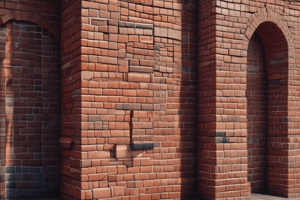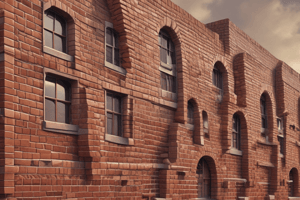Podcast
Questions and Answers
What is the primary material used in forming bricks?
What is the primary material used in forming bricks?
- Clay (correct)
- Limestone
- Sand
- Gypsum
Which elements are found in natural clay used for making bricks?
Which elements are found in natural clay used for making bricks?
- Calcium, Iron, Aluminum
- Silica, Potassium, Sodium
- Gold, Silver, Platinum
- Kaolinite, Illite, Montmorillonite (correct)
What happens to clay bricks when they are baked in a kiln?
What happens to clay bricks when they are baked in a kiln?
- They shrink in size
- They dissolve into mud
- They harden and strengthen (correct)
- They become soft and moldable
How are fired bricks transformed from their initial state?
How are fired bricks transformed from their initial state?
What distinguishes calcium silicate bricks from traditional clay bricks?
What distinguishes calcium silicate bricks from traditional clay bricks?
Which of the following elements is NOT part of the composition of calcium silicate bricks?
Which of the following elements is NOT part of the composition of calcium silicate bricks?
What is the main raw material used in the manufacturing process of calcium silicate bricks?
What is the main raw material used in the manufacturing process of calcium silicate bricks?
Which type of brick is a hybrid between traditional bricks and concrete?
Which type of brick is a hybrid between traditional bricks and concrete?
What is one advantage of Autoclaved Aerated Concrete (AAC) blocks mentioned in the text?
What is one advantage of Autoclaved Aerated Concrete (AAC) blocks mentioned in the text?
Which ancient civilizations are mentioned as users of bricks in construction?
Which ancient civilizations are mentioned as users of bricks in construction?
What role do bricks play in the construction of ancient Roman structures such as the Colosseum?
What role do bricks play in the construction of ancient Roman structures such as the Colosseum?
What characteristic makes concrete bricks different from traditional bricks?
What characteristic makes concrete bricks different from traditional bricks?
Flashcards are hidden until you start studying
Study Notes
Bricks: A Foundational Material Through the Ages
Bricks are a fundamental building block, literally and figuratively, for countless structures around the world. As you explore the composition of these ubiquitous pieces, we'll delve into their history, materials, and the variety that make them a timeless choice for construction.
Clays and Earth
From the onset, bricks have been primarily formed from natural clay—a soft earthy material rich in minerals and fine particles. Clay, a mixture of elements like kaolinite, illite, and montmorillonite, is moldable when wet but becomes hard and strong when baked in a kiln. Once shaped, this clay formulation, combined with sand and water, results in a dense, robust brick that's resistant to weathering and erosion.
Fired Bricks
The historical process of brickmaking has remained relatively unchanged for thousands of years. Clays are mixed with water, shaped into bricks, and then dried before being fired in a kiln. This firing process, aided by a fuel source like wood or coal, transforms the bricks, giving them their distinctive hardness and durability.
Calcium Silicate Bricks
Calcium silicate bricks, the modern counterpart to clay bricks, are made from a mixture of limestone, sand, and gypsum. These bricks are distinguished by their light weight, high strength, and resistance to water and chemicals. The manufacturing process for calcium silicate bricks involves mixing the raw materials into a slurry, extruding them into forms, and then firing them in a specially designed kiln.
Autoclaved Aerated Concrete Blocks (AAC)
A more recent alternative to traditional bricks is Autoclaved Aerated Concrete (AAC) blocks, also known as lightweight concrete blocks. These blocks are made from a mixture of cement, water, and a foaming agent that produces a highly porous material. AAC blocks are lightweight, yet strong, offer excellent thermal insulation, and can be manufactured in various shapes and sizes.
Concrete Bricks
Concrete bricks, a hybrid between traditional bricks and concrete, are made from a mixture of cement, sand, and water. These bricks offer the strength and durability of concrete while maintaining the traditional appearance of bricks. Concrete bricks can be produced in various sizes, shapes, and colors to suit specific construction needs.
Brick Usage Through History
Bricks have been used in construction since ancient civilizations like the Sumerians, Babylonians, and Egyptians. The brick's durability, strength, and ease of production made it a popular building material in the construction of homes, temples, and fortifications. Bricks were also used in the construction of the Roman aqueducts, Colosseum, and the cities of Pompeii and Herculaneum.
Conclusion
Bricks have evolved to meet the ever-changing demands of the construction industry, yet they remain a testament to human ingenuity and adaptability. The versatility and durability of bricks have made them a cornerstone of countless structures, from ancient civilizations to modern architectural marvels. As we explore new materials and manufacturing processes, brick will continue to be a crucial component in the built environment, connecting us to our past while looking to the future.
Studying That Suits You
Use AI to generate personalized quizzes and flashcards to suit your learning preferences.




